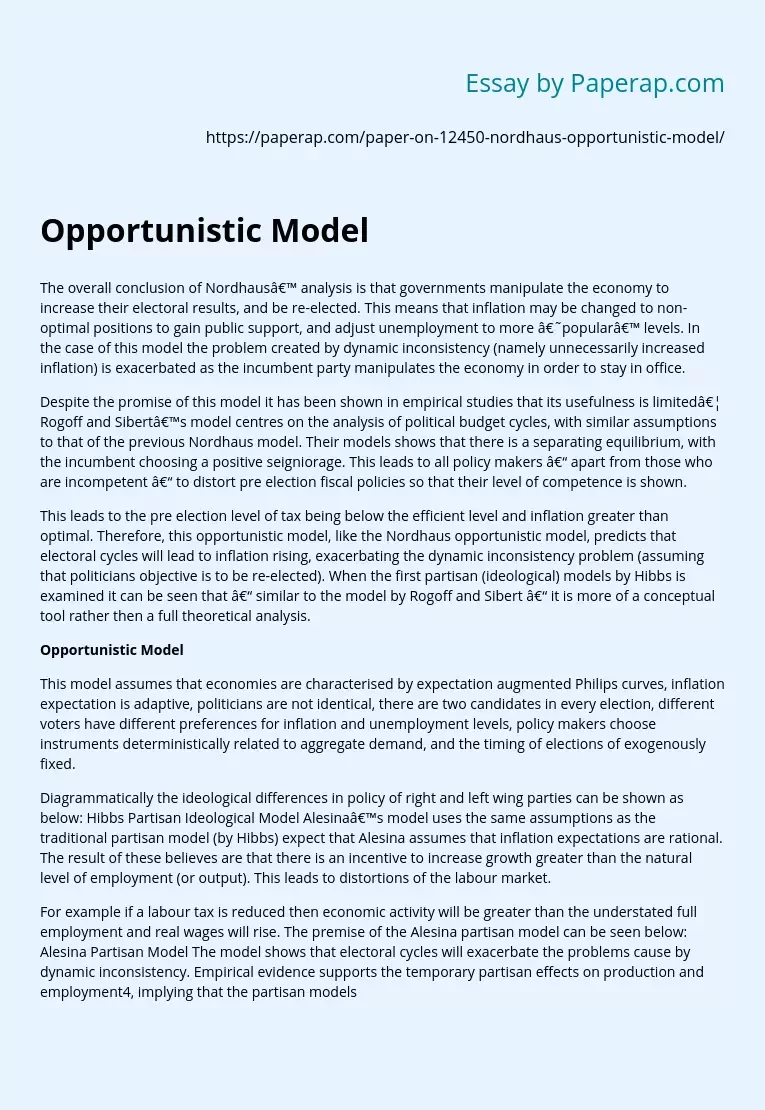Opportunistic Model
The overall conclusion of Nordhaus’ analysis is that governments manipulate the economy to increase their electoral results, and be re-elected. This means that inflation may be changed to non-optimal positions to gain public support, and adjust unemployment to more ‘popular’ levels. In the case of this model the problem created by dynamic inconsistency (namely unnecessarily increased inflation) is exacerbated as the incumbent party manipulates the economy in order to stay in office.
Despite the promise of this model it has been shown in empirical studies that its usefulness is limited… Rogoff and Sibert’s model centres on the analysis of political budget cycles, with similar assumptions to that of the previous Nordhaus model.
Their models shows that there is a separating equilibrium, with the incumbent choosing a positive seigniorage. This leads to all policy makers – apart from those who are incompetent – to distort pre election fiscal policies so that their level of competence is shown.
This leads to the pre election level of tax being below the efficient level and inflation greater than optimal.
Therefore, this opportunistic model, like the Nordhaus opportunistic model, predicts that electoral cycles will lead to inflation rising, exacerbating the dynamic inconsistency problem (assuming that politicians objective is to be re-elected). When the first partisan (ideological) models by Hibbs is examined it can be seen that – similar to the model by Rogoff and Sibert – it is more of a conceptual tool rather then a full theoretical analysis.
This model assumes that economies are characterised by expectation augmented Philips curves, inflation expectation is adaptive, politicians are not identical, there are two candidates in every election, different voters have different preferences for inflation and unemployment levels, policy makers choose instruments deterministically related to aggregate demand, and the timing of elections of exogenously fixed.
Diagrammatically the ideological differences in policy of right and left wing parties can be shown as below: Hibbs Partisan Ideological Model Alesina’s model uses the same assumptions as the traditional partisan model (by Hibbs) expect that Alesina assumes that inflation expectations are rational. The result of these believes are that there is an incentive to increase growth greater than the natural level of employment (or output). This leads to distortions of the labour market.
For example if a labour tax is reduced then economic activity will be greater than the understated full employment and real wages will rise. The premise of the Alesina partisan model can be seen below: Alesina Partisan Model The model shows that electoral cycles will exacerbate the problems cause by dynamic inconsistency. Empirical evidence supports the temporary partisan effects on production and employment4, implying that the partisan models are appropriate for such analysis.
Overall it can be seen that whether opportunistic or ideological in manner, political business cycle theory (in reference to electoral cycles) exacerbates the problems of higher inflation than could be attainable. This is due to parties and politicians artificially (and temporarily) inflating the economy to benefit from re-election for selfish power maximising reasons, or to implement ideological policies.
Opportunistic Model. (2019, Dec 05). Retrieved from https://paperap.com/paper-on-12450-nordhaus-opportunistic-model/

